 Decimals
Decimals
LEARNING OBJECTIVES
On completion of the materials provided in this chapter, you will be able to perform computations accurately by mastering the following mathematical concepts:
1 Reading and writing decimal numbers
2 Determining the value of decimal fractions
3 Adding, subtracting, multiplying, and dividing decimals
4 Rounding decimal fractions to an indicated place value
5 Multiplying and dividing decimals by 10 or a power of 10
6 Multiplying and dividing decimals by 0.1 or a multiple of 0.1
7 Converting a decimal fraction to a proper fraction
Study the introductory material for decimals. The processes for the calculation of decimal problems are listed in steps. Memorize the steps for each calculation before beginning the work sheet. Complete the work sheet at the end of this chapter, which provides for extensive practice in the manipulation of decimals. Check your answers. If you have difficulties, go back and review the steps for that type of calculation. When you feel ready to evaluate your learning, take the first posttest. Check your answers. An acceptable score as indicated on the posttest signifies that you are ready for the next chapter. An unacceptable score signifies a need for further study before you take the second posttest.
![]() Decimals are used in the metric system of measurement. Nurses use the metric system in the calculation of drug dosages. Therefore it is essential for nurses to be able to manipulate decimals easily and accurately.
Decimals are used in the metric system of measurement. Nurses use the metric system in the calculation of drug dosages. Therefore it is essential for nurses to be able to manipulate decimals easily and accurately.
Each decimal fraction consists of a numerator that is expressed in numerals; a decimal point placed so that it designates the value of the denominator; and the denominator, which is understood to be 10 or some power of 10. In writing a decimal fraction, always place a zero to the left of the decimal point so that the decimal point can readily be seen. The omission of the zero may result in a critical medication error. Some examples are as follows:
| Fraction | Decimal fraction |
 | 0.7 |
 | 0.13 |
 | 0.227 |
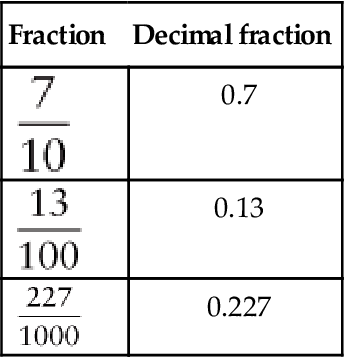
Decimal numbers include an integer (or whole number), a decimal point, and a decimal fraction. The value of the combined integer and decimal fraction is determined by the placement of the decimal point. Whole numbers are written to the left of the decimal point, and decimal fractions to the right. Figure 2-1 illustrates the place occupied by the numeral that has the value indicated.
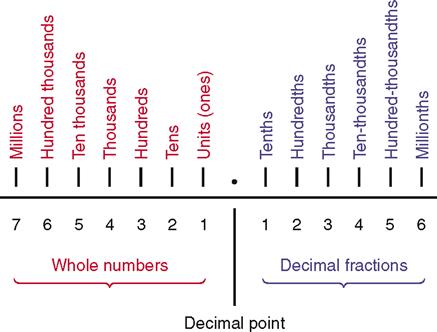
READING DECIMAL NUMBERS
The reading of a decimal number is determined by the place value of the integers and decimal fractions.
| EXAMPLES: | 0.4 | four tenths |
| 0.86 | eighty-six hundredths | |
| 3.659 | three and six hundred fifty-nine thousandths | |
| 182.0012 | one hundred eighty-two and twelve ten-thousandths | |
| 9.47735 | nine and forty-seven thousand seven hundred thirty-five hundred-thousandths |

DETERMINING THE VALUES OF DECIMAL FRACTIONS
1. Place the numbers in a vertical column with the decimal points in a vertical line.
2. Add zeros on the right in the decimal fractions to make columns even.
3. The largest number in a column to the right of the decimal point has the greatest value.
4. If two numbers in a column are of equal value, examine the next column to the right, and so on.
EXAMPLE 1: Of the following fractions (0.623, 0.841, 0.0096, 0.432), which has the greatest value? the least value?
0.841 has the greatest value; 0.0096 has the least value.
NOTE: In mixed numbers the values of both the integer and the fraction are considered.
EXAMPLE 2: Which decimal number (0.4, 0.25, 1.2, 1.002) has the greatest value? the least value?
ADDITION AND SUBTRACTION OF DECIMALS
1. Write the numerals in a vertical column with the decimal points in a straight line.
2. Add zeros as needed to complete the columns.
3. Add or subtract each column as indicated by the symbol.
4. Place the decimal point in the sum or difference directly below the decimal points in the column.
5. Place a zero to the left of the decimal point in a decimal fraction.
EXAMPLE 1: Add: 14.8 + 6.29 + 3.028

EXAMPLE 2: Subtract: 5.163 − 4.98

MULTIPLICATION OF DECIMALS
1. Place the shorter group of numbers under the longer group of numbers.
2. Multiply.
4. Count from right to left the value of the sum and place the decimal point.
EXAMPLE 1: 0.19 × 0.24
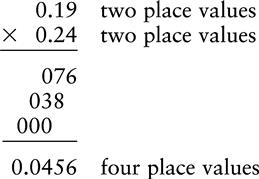
EXAMPLE 2: 0.459 × 0.52
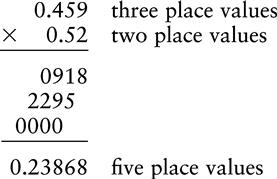
EXAMPLE 3: 8.265 × 4.36
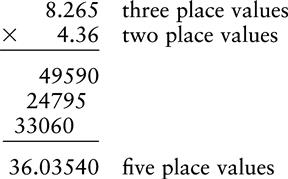
EXAMPLE 4: 160.41 × 3.527
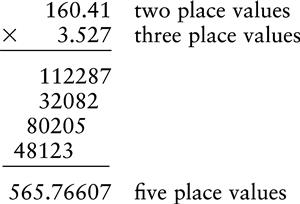
Multiplying a Decimal by 10 or a Power of 10 (100, 1000, 10,000, 100,000)
1. Move the decimal point to the right the same number of places as there are zeros in the multiplier.
EXAMPLE 1:

EXAMPLE 2:

EXAMPLE 3:

EXAMPLE 4:

Multiplying a Whole Number or Decimal by 0.1 or a Multiple of 0.1 (0.01, 0.001, 0.0001, 0.00001)
EXAMPLE 1:

EXAMPLE 2:

EXAMPLE 3:

EXAMPLE 4:

ROUNDING A DECIMAL FRACTION
1. Find the number to the right of the place value desired.
3. If the number is 0, 1, 2, 3, or 4, remove all numbers to the right of the desired place value.
EXAMPLE 1: Round the following decimal fractions to the nearest tenth.
| a. | 0.268 | |
| 0.2)68 | 6 is the number to the right of the tenth place. Therefore 1 should be added to the number 2 and the 68 dropped. | |
| 0.3 | correct answer | |
| b. | 4.374 | |
| 4.3)74 | 7 is the number to the right of the tenth place. Therefore 1 should be added to the number 3 and the 74 dropped. | |
| 4.4 | correct answer | |
| c. | 5.723 | |
| 5.7)23 | 2 is the number to the right of the tenth place. Therefore all numbers to the right of the tenth place should be removed. | |
| 5.7 | correct answer |

EXAMPLE 2: Round the following decimal fractions to the nearest hundredth.
| a. | 0.876 | |
| 0.87)6 | 6 is the number to the right of the hundredths place. Therefore 1 should be added to the number 7 and the 6 dropped. | |
| 0.88 | correct answer | |
| b. | 2.3249 | |
| 2.32)49 | 4 is the number to the right of the hundredths place. Therefore all numbers to the right of the hundredths place should be removed. | |
| 2.32 | correct answer |

EXAMPLE 3: Round the following decimal fractions to the nearest thousandth.
| a. | 3.1325 | |
| 3.132)5 | 5 is the number to the right of the thousandths place. Therefore 1 should be added to the number 2 and the 5 dropped. | |
| 3.133 | correct answer | |
| b. | 0.4674 | |
| 0.467)4 | 4 is the number to the right of the thousandths place. Therefore all numbers to the right of the thousandths place should be removed. | |
| 0.467 | correct answer |
Rounding numbers helps to estimate values, compare values, have more realistic and workable numbers, and spot errors. Decimal fractions may be rounded to any designated place value.
DIVISION OF DECIMALS
2. Count the number of spaces that the decimal point is moved in the divisor.
4. Place a decimal point on the quotient line directly above the caret.
5. Divide, extending the decimal fraction three places to the right of the decimal point.
6. Zeros may be added as indicated to extend the decimal fraction dividend.
EXAMPLE 1: 8.326 ÷ 1.062

EXAMPLE 2: 386 ÷ 719
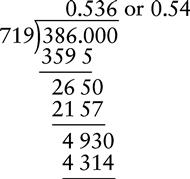
NOTE: The decimal fraction is emphasized by the placement of a zero to the left of the decimal point.
Dividing a Decimal by 10 or a Multiple of 10 (100, 1000, 10,000, 100,000)
Stay updated, free articles. Join our Telegram channel

Full access? Get Clinical Tree


